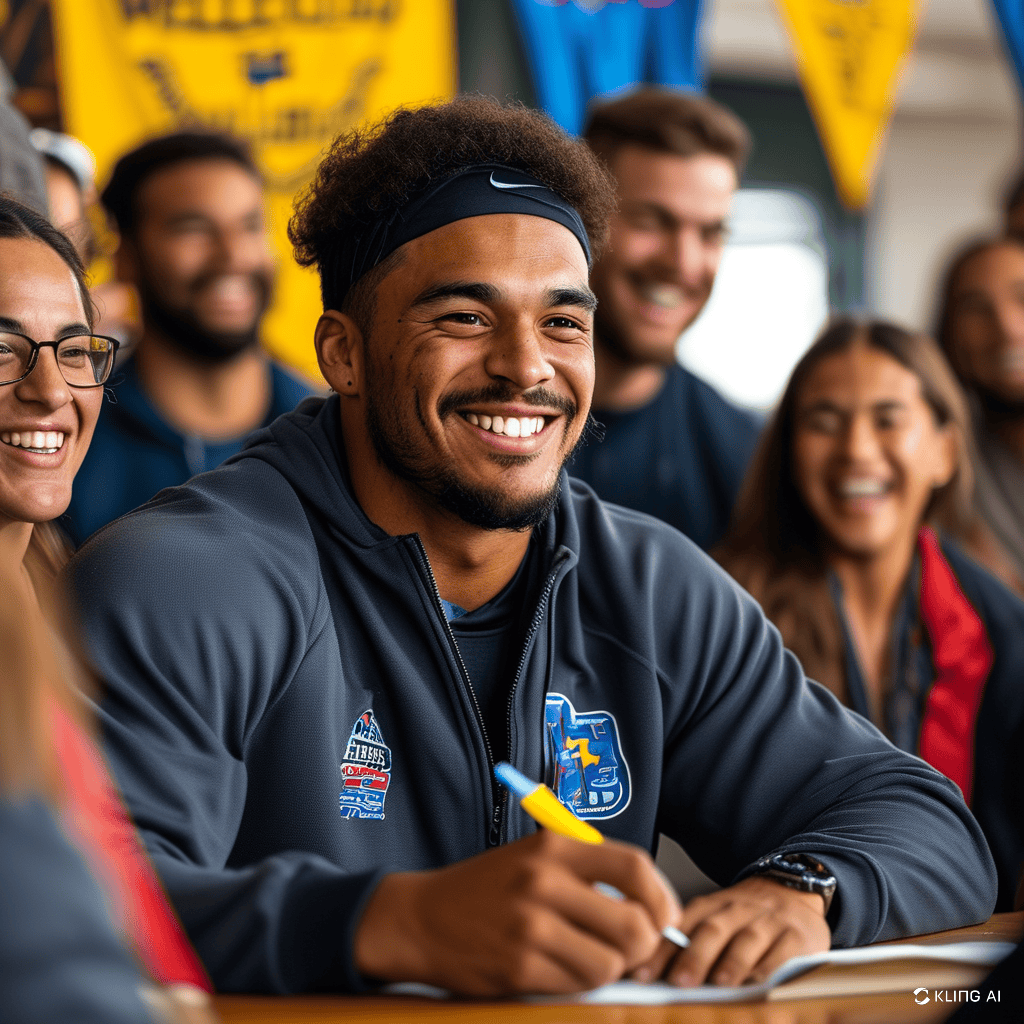National Signing Day is a crucial event in the world of college football. It marks the first day that high school seniors can officially commit to NCAA member schools by signing binding letters of intent. Traditionally held on the first Wednesday of February, this day has grown into a national celebration, enjoyed by athletes, coaches, and fans alike.
National Signing Day replaced conference-specific signing days that were held until 1981. This change was made to create a unified national event that would simplify the recruiting process and make it more exciting for everyone involved.
The importance of National Signing Day goes beyond just being a date on the calendar:
- For student-athletes: It represents the culmination of years of hard work and dedication. Signing an NLI (National Letter of Intent) not only secures their spot on a college team but also often provides them with scholarships that make higher education more accessible.
- For colleges: Securing top talent on National Signing Day is crucial for building competitive teams. Coaches spend months scouting and recruiting players, aiming to fill their rosters with the best possible talent to enhance their programs’ success.
National Signing Day continues to shape the future of college football, influencing recruiting strategies and setting the stage for emerging talent in the sport.
The Evolution of National Signing Day
Origins of National Signing Day and Its Establishment
National Signing Day began as a response to the need for a standardized recruiting process in college football. Prior to its establishment, each conference had its own signing days, creating a chaotic and competitive environment. By 1981, the NCAA introduced a unified National Signing Day, streamlining the recruitment process for athletes and colleges alike.
Transition from Conference-Specific Signing Days to a National Event
Before 1981, conferences conducted their signing events on different dates, which often led to confusion and logistical challenges. The transition to a single national event was pivotal. It provided clarity and uniformity, ensuring that all student-athletes had equal opportunities to make informed decisions about their collegiate careers. This shift also helped colleges plan their recruiting strategies more efficiently.
Introduction of the Early Signing Period in December (2017)
The landscape of National Signing Day experienced another significant change in 2017 with the introduction of an early signing period in December. This addition allowed high school athletes to commit to colleges ahead of the traditional February date. For many programs, this early signing period has become crucial:
- Coaches secure commitments from top recruits earlier.
- Athletes gain peace of mind, avoiding last-minute pressures.
- Recruiting strategies adapt, with schools filling substantial roster spots before the new year.
This evolution reflects the dynamic nature of college football recruiting and underscores the importance of staying updated with NCAA regulations and timelines.
Understanding the National Letter of Intent (NLI)
The National Letter of Intent (NLI) is a binding agreement between a student-athlete and an educational institution. It guarantees that the athlete will attend the institution for at least one academic year in exchange for an athletic scholarship. This agreement is crucial in organizing and regulating college sports recruiting.
Definition and Purpose of the NLI
The NLI serves two main purposes:
- Definition: It is a formal document that solidifies the commitment between a high school senior and a college.
- Purpose: Its primary goal is to ensure that student-athletes receive financial aid and to prevent other schools from recruiting athletes who have already signed.
Legal Implications and Commitments Involved in Signing an NLI
When a student-athlete signs an NLI, several legal commitments come into play:
- Binding Nature: Once signed, both parties are legally obligated to honor the agreement for one academic year.
- Scholarship Implications: The institution must provide financial aid for at least one year, contingent on the student maintaining academic and athletic eligibility.
- Recruiting Restrictions: Other schools are prohibited from recruiting an athlete who has signed an NLI with another institution.
Differences Between NLI for D1, D2 Schools, NAIA, NJCAA
The NLI program varies across different athletic divisions:
- Division I (D1) and Division II (D2):
- Governed by NCAA.
- Strict adherence to specific signing periods.
- Financial aid packages often more substantial due to higher revenue sports like football and basketball.
- NAIA (National Association of Intercollegiate Athletics):
- Less restrictive compared to NCAA guidelines.
- Typically offers smaller scholarships or partial financial aid.
- NJCAA (National Junior College Athletic Association):
- Focuses on community colleges.
- Provides opportunities for athletes aiming to transfer to four-year institutions later.
Understanding these distinctions helps student-athletes make informed decisions about their college careers while ensuring they meet all legal requirements. This knowledge empowers recruits to navigate their options effectively, aligning their athletic ambitions with educational goals.
Key Dates and Timelines for National Signing Day
National Signing Day dates for 2024-2025 are critical for both student-athletes and college programs. The traditional signing day occurs on the first Wednesday of February, making it a highly anticipated event each year. For the 2024 signing period, this day falls on February 7, 2024.
Early Signing Periods vs. Traditional Signing Day
The early signing period, introduced in December 2017, offers recruits an opportunity to secure their college commitments before the new year. The upcoming early signing period for the 2024 class is scheduled from December 18-20, 2023.
Key differences between these periods include:
- Early Signing Period: Allows coaches to lock in top recruits earlier, providing stability and reducing uncertainty.
- Traditional Signing Day: Often sees a flurry of last-minute decisions and can be crucial for filling remaining roster spots.
Implications on Recruiting Strategies
Recruiting strategies adapt significantly based on these timelines:
- Coaches: Utilize the early period to secure high-priority targets, ensuring that they don’t miss out on top talent.
- Athletes: Gain the advantage of securing their spot early, reducing stress and allowing them to focus on their final high school season.
Recruiting calendars now revolve around these key dates, ensuring that both coaches and athletes are well-prepared for National Signing Day.
The Recruiting Process Leading Up to Signing Day
The recruiting process for high school athletes is a journey marked by several critical steps. Understanding and navigating this pathway can significantly impact a student-athlete’s future.
Steps in the Recruiting Process:
- Initial Contact: College coaches often begin with phone calls, emails, or letters to express interest.
- Evaluation: Coaches evaluate athletes’ skills through game footage, stats, and scouting reports.
- Visits: Athletes may take unofficial visits to campuses, followed by official visits if mutual interest persists.
- Offers: Scholarships and offers are extended based on evaluations and needs of the program.
- Commitment: Verbal commitments can be made before signing the National Letter of Intent (NLI).
Importance of Understanding NCAA Rules and Regulations:
NCAA rules and regulations play a pivotal role in maintaining fair competition and ensuring eligibility. Student-athletes need to:
- Meet academic requirements such as GPA and standardized test scores.
- Adhere to amateurism standards, avoiding professional contracts or agent agreements.
- Follow recruiting calendars that dictate permissible contact periods with college coaches.
Role of Coaches in Guiding Recruits:
Coaches are instrumental in guiding recruits through this complex process. They provide:
- Insight into NCAA regulations to ensure compliance.
- Honest assessments of athletes’ abilities and potential fit within their programs.
- Support during decision-making phases, helping athletes weigh their options wisely.
Understanding these elements not only smoothens the path to signing day but also sets the stage for future success both academically and athletically.
The Impact of Early vs. Late Signing
Understanding the impact of signing early vs late is crucial for student-athletes and their families.
Advantages of Early Signing:
- Commitment Security: Early signing provides peace of mind by securing a spot on the team.
- Scholarship Assurance: Athletes can lock in scholarships before other recruits fill available spots.
- Reduced Recruitment Pressure: Lessens the stress of ongoing recruitment, allowing students to focus on academics and senior-year athletics.
Disadvantages of Early Signing:
- Limited Exploration Time: Early signers may miss out on opportunities from other schools that show interest later.
- Coaching Changes: A coaching change after early signing can lead to mismatches between athletes and new coaching strategies.
- Injury Risk: Committing early does not mitigate risks such as injuries that could affect future performance.
Timing’s Effect on Scholarship Availability and Roster Spots
Signing timing directly impacts scholarship availability. Early signers secure financial aid before it runs out, while late signers might find fewer options. Coaches plan rosters based on early commitments, which can either benefit or disadvantage athletes who wait until traditional signing day.
Case Studies Illustrating Different Outcomes
- Example 1: A top quarterback who signed early with an SEC school secured a full scholarship and starting position, benefitting from immediate integration into the team’s system.
- Example 2: A defensive lineman waited until February to sign, receiving multiple offers after a standout senior season but faced limited scholarship funds compared to earlier committers.
Examining these scenarios helps highlight how timing can shape both immediate and long-term outcomes for student-athletes in college football recruiting.
Celebrating Student-Athletes on National Signing Day
National Signing Day events hold immense cultural significance within the realm of college football. These events are more than just ceremonial; they symbolize the culmination of years of hard work, dedication, and perseverance for high school athletes. Families, coaches, and communities gather to celebrate students who have achieved the milestone of committing to collegiate programs.
Various organizations, such as SkillsUSA, also take part in celebrating student achievements. SkillsUSA, known for promoting skilled career paths, often highlights the stories of student-athletes who balance both academic and athletic pursuits. Their recognition goes beyond football, emphasizing the holistic development of young individuals.
Spotlight on Success Stories
- Trevor Lawrence: The former Clemson quarterback signed on National Signing Day in 2018. His commitment was a pivotal moment not only for Clemson but also for his career trajectory.
- Derrick Henry: Signed with Alabama in 2013, Henry went on to win the Heisman Trophy and establish himself as one of the NFL’s elite running backs.
- Kyler Murray: Committed to Texas A&M before transferring to Oklahoma. His signing day decision laid the foundation for a stellar college career culminating in a Heisman Trophy win and an NFL first overall draft pick.
These success stories underscore the transformative impact that National Signing Day can have on student-athletes’ lives, setting them on paths toward future success both on and off the field.
The Role of Major Conferences in Shaping Recruiting Trends
Major programs like those in the SEC, Big Ten, and ACC play a crucial role in shaping recruiting trends. These conferences consistently produce successful recruiting classes, often setting benchmarks for other programs.
Analysis of Successful Recruiting Classes
Top programs within these conferences frequently secure the highest-rated recruits:
- SEC: Dominates with powerhouse programs like Alabama and Georgia. Their ability to attract elite talent is unmatched.
- Big Ten: Schools like Ohio State and Michigan lead the conference, often boasting top-five national recruiting classes.
- ACC: Clemson has risen to prominence with strong recruiting efforts, challenging traditional powerhouses.
Utilization of National Signing Day
These programs leverage National Signing Day to their advantage by:
- Building Momentum: High-profile signings create media buzz, which helps in attracting future talent.
- Strategic Planning: Coaches use early commitments to address key roster needs, ensuring depth and balance.
- Showcasing Success: Publicly celebrating signings enhances a program’s reputation, making it more appealing to prospective recruits.
Influence on Recruitment Tactics
Major conferences influence recruitment tactics through:
- Innovative Approaches: Utilizing social media and digital platforms to engage recruits.
- Comprehensive Support Systems: Offering robust academic and athletic support to attract well-rounded student-athletes.
The strategies employed by these top programs set trends that ripple throughout college football recruiting, impacting how other schools approach National Signing Day.
Challenges Faced by Student-Athletes During the Signing Process
Recruits face numerous challenges during the signing process. These can range from intense competition to navigating NCAA regulations. Here are some common hurdles:
1. Pressure and Expectations
High school athletes often deal with immense pressure from coaches, family, and peers to make the “right” choice.
2. Complex Decision-Making
Balancing academics, athletics, and personal preferences can complicate decision-making.
3. NCAA Compliance
Understanding and adhering to NCAA rules is critical to maintain eligibility.
The emotional stressors athletes encounter also play a significant role. Committing to a college involves:
- Emotional Commitment: The decision is not only a logistical one but an emotional commitment that impacts their future profoundly.
- Fear of Missing Out (FOMO): Athletes often worry about missing better opportunities or making the wrong choice.
Support systems available to student-athletes during this time include:
- Coaches and Mentors: They offer guidance through the recruiting process, helping athletes understand their options.
- Family Support: Family members provide emotional backing and help in weighing pros and cons.
- School Counselors: They assist with academic readiness and compliance with NCAA regulations.
Understanding these challenges is crucial for anyone involved in the recruitment process, ensuring student-athletes receive the support they need to thrive both on and off the field.
Future Trends in National Signing Day
Predictions for Evolution in Coming Years
The future National Signing Day is expected to adapt to the ever-changing landscape of college football recruitment. One significant trend is the potential expansion of the early signing period, giving athletes and coaches more flexibility.
Potential Changes in NCAA Regulations
Changes in NCAA regulations could reshape recruiting strategies. There’s ongoing discussion about introducing more lenient transfer rules or additional signing periods. These adjustments could impact how coaches allocate scholarships and manage rosters.
Role of Technology in Future Signings
Technology will play a crucial role in enhancing athlete visibility. Platforms like Hudl and social media channels allow athletes to showcase their skills to a wider audience. Virtual reality (VR) could also emerge as a tool for virtual campus visits, making it easier for recruits to explore schools remotely.
- Enhanced Athlete Visibility: Social media and digital platforms providing broader reach.
- Virtual Campus Visits: VR technology facilitating remote exploration of colleges.
- Expanded Early Signing Periods: Potential increase in flexibility for recruits and coaches.
As these trends unfold, the landscape of National Signing Day will continue to evolve, offering new opportunities and challenges for student-athletes and colleges alike.















